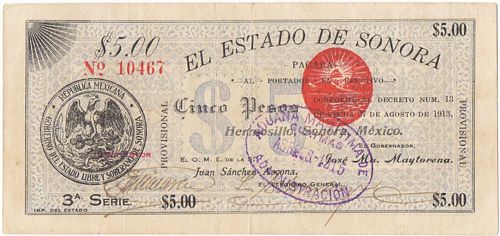Revalidations on Estado de Sonora notes
On 28 February 1914 Carranza’s decree (núm. 21) at Nogales made the authorised paper money issues of six states, including these Estado de Sonora, forced currency throughout the territory controlled by the Constitutionalists, and there are occasional references to the use of Sonora notes within that areaFor example, in November 1914 the Paymaster General in Saltillo received from the Tesorería General in Mexico City a large quantity of notes of Sonora, Sinaloa, Durango, Jalisco and other states with which to pay the troops. Through the public were reminded that these were obligatory tender there were many complaints (AMS, caja 157, legajo 9, exp. 8 letter General Luis Gutiérrez to Presidente Municipal, Saltillo 18 November 1914). However, they were mainly confined to Sonora and SinaloaIn 1913 there was some reciprocal agreement about accepting the currency of these two states. On 24 October 1913 the Governor of Sinaloa, Felipe Riveros, decreed the notes of Sonora to be of forced circulation within his state (Periódico Oficial, 29 December 1913). In November notes of the Estado de Sinaloa could be exchanged for Sonora currency in the Tesorería General, in Hermosillo, and at the Administraciones de Rentas, Agencias Fiscales and Municipal Treasuries in the districts (Justicia, Cananea, 18 November 1913). Alamos was told on 29 November that Sinaloa notes were of forced circulation. On 29 December 1913 Cananea reported that many people held Sinaloa notes but that their acceptance was poor. Everyone, even the public offices, was refusing them, as apparently they were not forced. Hermosillo replied that they had been suspended since counterfeits existed (AGHES, Fondo Oficialidad Mayor, tomo 2971). In January 1914 the Sonoran Treasury ordered the Municipal Treasuries temporarily not to accept Sinaloa notes because forgeries existed..
Many of the notes, mainly of the higher values, were restamped as proof of their genuineness or of their forced circulation within a particular area.
On 11 February 1915 José María Maytorena, the governor of Sonora, in Nogales, issued circular núm. 1 with instructions for customs officials. Everyone entering the country was to be asked if they were bringing in paper currency. If the person answered no, they were to be allowed to pass, unless the official suspected they were lying: in which case they were to be searched. If they were found to be carrying legitimate currency, it was to be confiscated: if they were found to be carrying any counterfeit notes they were to be consigned to the nearest political authority. Whenever anyone handed in currency for inspection, it was to be checked by the official. Good notes were to be returned, marked with the official’s initials, whilst counterfeit notes were to be punch-stamped (with holes at least 1cm in diameter) through the serial numbers, stamped FALSO in indelible ink and returned. Circular núm. 2, of 12 February 1915, laid down similar regulations for shipping agents such as Wells Fargo and CompanyAGHES, Fondo Oficialidad Mayor, tomo 3024.
Officials
The Sonoran government, with the help of the Tesorería General of Chihuahua, established an office in charge of inspecting and revalidating notes. Most of the surviving correspondence dates from April and May 1915: this might just be fortuitous but as those resellos with dates also come from this period it seems that the authorities did not take matters particularly seriously until large numbers of counterfeit Chihuahua notes started appearing along the border.
The various officials working in the department included:
Remigio Montoya: Montoya worked in Nogales. He had been sent by the Tesorería General in Chihuahua but on 11 March 1915 Maytorena requested a replacement because Montoya had been arrested after being found restamping and signing a quantity of counterfeit notesJMM papers, box folder , 11 March 1915. Montoya was caught, with his accomplices, stamping $50,000 in counterfeit $20 dos caritasJMM papers, box Maytorna to Escudero, Chihuahua, 12 March 1915. The Los Angeles Times claimed that the counterfeit paper currency taken in at Nogales, amounting to about $500,000 in face value, was carefully saved, and that it was taken to Tucson by Montoya himself, who spent about ten nights busily rubber-stamping all of it as genuine. His mysterious operations were reported to the Sheriff, who raided the room, and found not only the expert and his rubber stamps, but several prominent residents of Sonora. It was claimed that no less than twenty-eight Mexican officials were implicated by an investigation set on foot by Maytorena and that most of them fled to the United StatesTucson Daily Citizen, 17 March 1915: Los Angeles Times, 29 March 1915.. Chihuahua sent Francisco Porras as a replacementJMM papers, Vargas to Maytorena, 13 March 1915 and Villa himself, from Torreón, ordered that if Montoya was found guilty he should be severely punished pour encourager les autresJMM papers, box 5, folder 3, Escudero to Maytorena, 13 March 1915. However, Montoya seems to have been absolvedIt seems that although several prominent members of the Maytorena regime were implicated they fled to the States and only two underlings were executed. "Two of the men who were implicated in the stamping of the bogus money so that it could be passed were executed. As far as can be learned none of the higher-ups who were in the money conspiracy have been arrested. Some of them are still on this side of the line" (Tucson Daily Citizen, 31 March 1915). One newspaper reported that a Montoya was executed. On 24 March 1915 it was reported from Nogales that Manuel Montoya, paymaster general (Pagador General) of the Maytorenista troops had been executed for paying his subordinates with counterfeit money, keeping the genuine notes for himself (Prensa, 28 March 1915), one way or another, because by April Vargas confirmed that one of the $20 Serie E notes that Montoya remitted was legitimateJMM papers, box 5, folder 6 letter J. J. Goodman & Co., Nogales to Maytorena, 22 April 1915. Ironically, a neswpaper reported that James Goodman, an American, and twenty-two other Americans were arrested in Nogales, Sonora on charges of circulating counterfeit Mexican currency. $100,000 in Mexican currency was taken from the prisoners (El Paso Herald, 13 March 1915) and by 9 May Montoya was working in Guaymas. The Prefecto Municipal asked Maytorena to let him stay a couple of days longer to revalidate the billetes de firma (Chihuahuan sábanas?) which Rivas (see below) had been unable to recogniseJMM papers, box 5, folder 9, telegram Presidente Municipal Escalente to Maytorena, 9 May 1915.
Francisco J. Cabezud: was the inspector in Nogales. He started on 16 March 1915 and resigned his post, on taking up another commission, on 29 May 1915. During his tenure he revalidated $1,387,631 ($166,800 in March, $714,196 in April and $506,635 in May)JMM papers, box 5, folder 12, letter Cabezud to Maytorena, 26 May 1915.
Ramón. D. Gamelon: worked as an assistant to Cabezud (Ayudante del Revisador de Papel Moneda) in Nogales but resigned in 15 May 1915 to go to La Paz, Baja California for family reasonsJMM papers, box 5, folder 10, item 42.
Daniel. R. Aguilar: took over from Gamelon as an assistant to Cabezud on 19 May 1915, on a monthly salary of $100JMM papers, box 5, folder 11, letter Maytorena to Cabezud, 19 May 1915.
José P. González: was the inspector in Cananea. González worked for the Tesorería General in Chihuahua. Sebastian Vargas, hijo, the Chihuahua Treasurer General, sent González to Sonora in April, asking Maytorena to send him back when his services were no longer required so that he could be deployed somewhere elseJMM papers, box 6, Vargas to Maytorena, 26 May 1915. González arrived at Nogales on 14 April 1915JMM papers, box 5, folder 6, item 9. On 29 April he was in Naco stamping the various issues of Mexican currency in circulation there. Enrique Acosta, the new customs collector at Naco, said that all currency in circulation had to be brought in for examination. A considerable amount was rejected, but the majority was approved with González' initials and official stamp. Owing to the fact that the medium of value in Naco was principally the American dollar, González did not have a great deal of work to do. González left on 30 April for CananeaThe Bisbee Daily Review, 30 April 1915. He was in Naco on 2 May, in Cananea by 4 May and there on 20 May. On 25 May the Administrador of the customs at La Morita, Naco again asked for his services and the next week Maytorena replied that he would send him as soon as he was ableJMM papers, box 5, folder 12, 31 May 1915. On 27 May González was instructed to go to Villa Verde to revalidate the pay for the troops thereJMM papers, box 5, folder 12, Maytorena to González, 27 May 1915.
Camilo E. Ortiz: was the inspector in Hermosillo. He was in place by 7 May 1915. Ortiz was making housecalls because on 11 May, together with the Comandante de Policía, he visited Las Fábricas de Francia of H. James y Cia., Sucs. The business had received a large sum of money from a casa comercial in Guadalajara, but each note had been revalidated, some in Nogales and the rest in Guaymas. Some of the notes found had false resellos, and the manager, Agustín Beraud, claimed that these had been given by the Aduana de Nogales to the First National Bank. Beraud also claimed another American had recently deposited $5,000 in billetes resellados that he obtained in Nogales that had turned out to be falseJMM papers, box 5, folder 10, letter 14 May 1915. In early June Ortiz left for La Colorada, to restamp the notes therePrensa, 14 June 1915.
Francisco F. Porras: was the inspector in Guaymas. He was an employee of the Tesorería General in Chihuahua and was sent to Sonora in March 1915 to replace Remigio Montoya JMM papers, box 5, folder 3, item 21, Sebastian Vargas to José Maytorena, 13 March 1915. On 17 May he was in Cocorit, and ordered to go to Fundición (halfway between Cocorit and Navojoa) to check the notes thereJMM papers, box 5, folder 11, Maytorena to Porras, 17 May 1915..
A. G. Rivas: was already working in Guaymas when he was appointed on 15 May 1915, on a monthly salary of $300JMM papers, box 5, folder 10, Maytorena to Rivas, 15 May 1915.
It is strange that, despite the references to initials, only Rivas initialled Estado de Sonora notes whereas the other officials put their initials to their revalidation of Chihuahua notes.
Revalidation did not automatically confer acceptance, particularly given the number of counterfeit notes (and the existence of counterfeit resellos). On 5 May 1915 Maytorena wrote to the Prefectura in Nogales instructing them rigorously to apply the law to ensure that notes that had been revalidated by his inspectors should be acceptedPrensa, 8 May 1915.
Recorded resellos
Recorded resellos are:
Nogales - Aduana Fronteriza
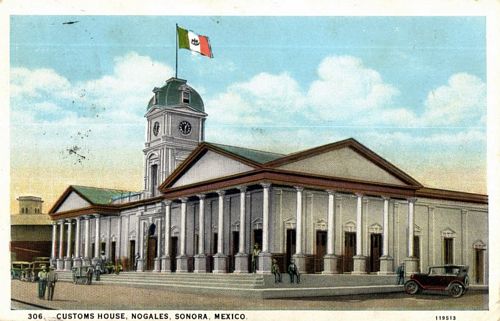
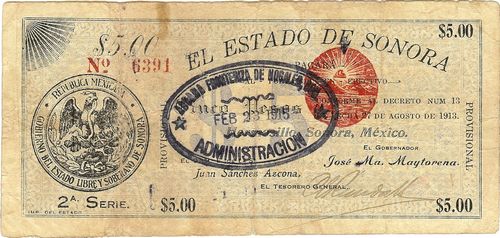
 A black oval (56 x 35mm) stamp with ‘ADUANA FRONTERIZA DE NOGALES SON. - ADMINISTRACION’ and date in centre. Known dates range from [ February 1915] to [ 1915] and the overprint is found on either the front or the back of the note.
A black oval (56 x 35mm) stamp with ‘ADUANA FRONTERIZA DE NOGALES SON. - ADMINISTRACION’ and date in centre. Known dates range from [ February 1915] to [ 1915] and the overprint is found on either the front or the back of the note.
This stamp was used for checking currency that had been brought in from the United States, and was used by Montoya until mid March 1915.
Nogales - Fuerzas del Estado

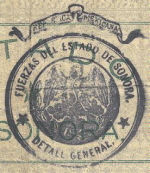 A 49mm diameter round black stamp with eagle in centre and ‘FUERZAS DEL ESTADO DE SONORA - DETALL GENERAL’ around with a ribbon with ‘REPUBLICA MEXICANA’ above.
A 49mm diameter round black stamp with eagle in centre and ‘FUERZAS DEL ESTADO DE SONORA - DETALL GENERAL’ around with a ribbon with ‘REPUBLICA MEXICANA’ above.
This stamp was used in Nogales from March 1915. On 16 March 1915 Governor Maytorena issued a notice[text needed] informing the public that he had commissioned Francisco J. Cazebud to oversee the revision and revalidation of notes. Therefore notes sealed until the previous day with the “Administración de la Aduana de Nogales, Sonora” and the initials “R. M.” were valid, and henceforth notes would have a “República Mexicana. Fuerzas del Estado de Sonora. Detall General” seal and the initials “F. J. C.”Prensa, San Antonio, 19 March 1915.
Altar - Prefectura del Distrito
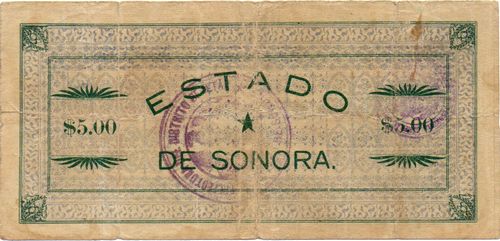
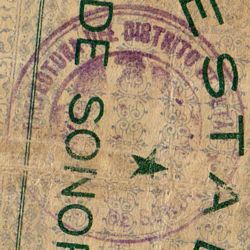 A circular seal with 'PREFECTURA DEL DISTRITO DE ALTAR - ESTADO DE SONORA'
A circular seal with 'PREFECTURA DEL DISTRITO DE ALTAR - ESTADO DE SONORA'
Magdalena - Ayuntamiento
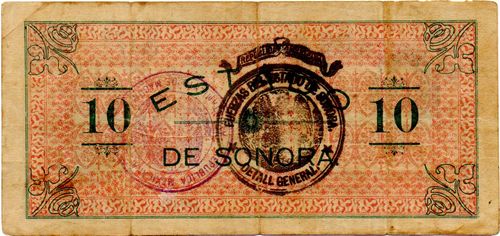
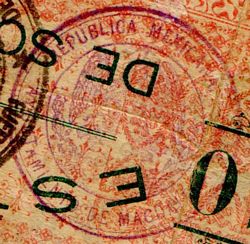
A circular seal with 'REPUBLICA MEXICANA - AYUNTAMIENTO DE MAGDALENA' and eagle in centre.
Cananea - Presidencia Municipal
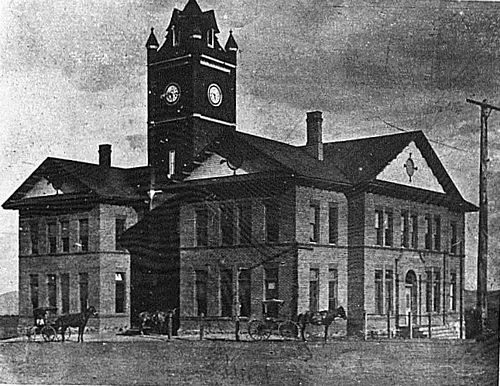
Palacio Municipal, Cananea
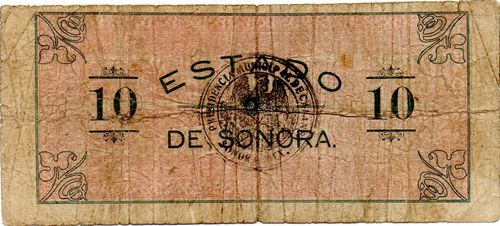
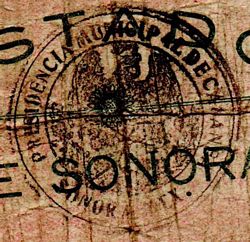 A round black stamp inscribed 'PRESIDENCIA MUNICIPAL DE CANANEA, SONORA, MEX'.
A round black stamp inscribed 'PRESIDENCIA MUNICIPAL DE CANANEA, SONORA, MEX'.
On 13 May 1915 the government said businesses in Arizpe could send their money for revalidation to Cananea, where there was an inspectorJMM papers, box 5, folder 10, item 30, who would have been José P. González.
[ ] - Comisaria de Policia
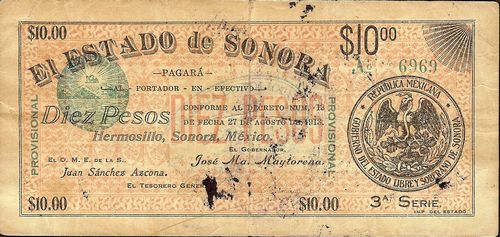
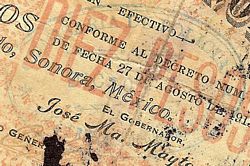 An oval seal with 'COMISARIA DE POLICIA - [ ] with date in centre.
An oval seal with 'COMISARIA DE POLICIA - [ ] with date in centre.
This note has an Aduana Fronteriza resello on the reverse, so might be from the north of the state, and thr date [ ] December [ ] in its seal. We need to identify its source before we can decide whether this is an actual revalidation or an identifying stamp, perhaps in connection with a courtcase.
Hermosillo - Secretaría Particular
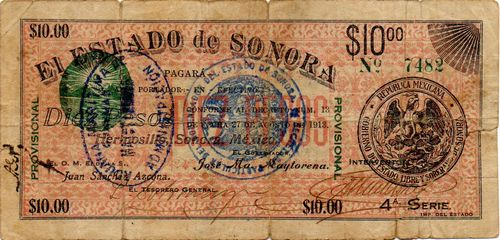
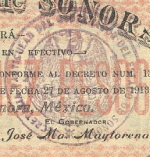 A 39mm round seal with eagle in centre and ‘SECRETARIA PARTICULAR DEL GOBERNADOR DE SONORA’ around. This stamp was used with both black (?) and violet ink.
A 39mm round seal with eagle in centre and ‘SECRETARIA PARTICULAR DEL GOBERNADOR DE SONORA’ around. This stamp was used with both black (?) and violet ink.
This resello was used in Nogales from 28 May 1915 by the inspector, Remigio Montoya, whose initials, RM, appear next to the reselloJMM papers, box 5, folder 12 Aviso al Público, 28 May 1915. It would appear that this seal was used not because of any connection with the Secretario Particular (or Hermosillo) but merely because of a shortage of rubber stampsOn 15 May Maytorena wrote to the Luis Gaxiola of the Agencia Financiera in Ciudad Juárez asking for six rubber stamps reading “Comision Revisadora de Billetes del Estado de Sonora” (JMM papers, box 5, folder 10).
Hermosillo - Tesorería General
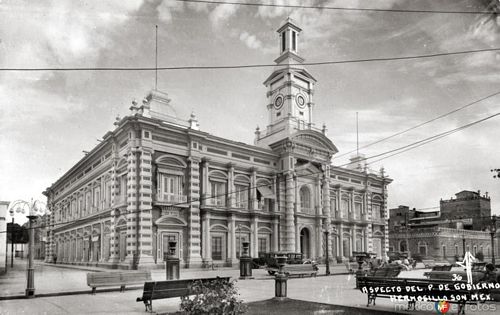
Palacio de Gobierno, Hermosillo
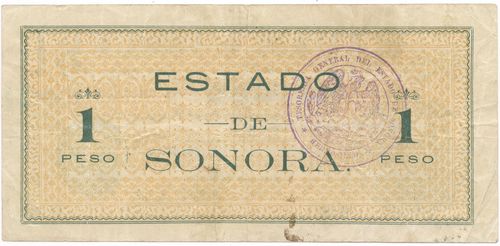
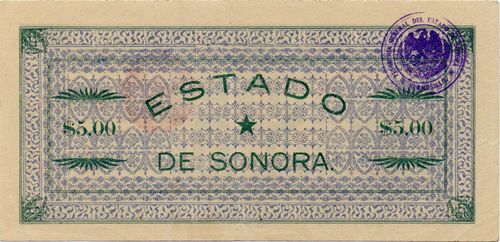
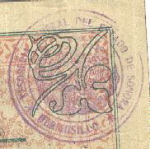 two different size round seals (39mm and 28mm) with ‘TESORERIA GENERAL DEL ESTADO DE SONORA – HERMOSILLO’ around an eagle. The larger stamp was used with black and violet ink.
two different size round seals (39mm and 28mm) with ‘TESORERIA GENERAL DEL ESTADO DE SONORA – HERMOSILLO’ around an eagle. The larger stamp was used with black and violet ink.
These were presumably used not only in Hermosillo but by the various inspectors who were sent out to check notes.
On 12 April 1915 the authorities at Poza were asking whether notes had to be restamped in order to be compulsory as businesses were refusing to accept notes which lacked resellos. They were told to accept them, whilst an official was sent to restamp them. Two weeks later Sahuaripa was asking for someone to be sent to restamp notes as the public were refusing them. They were also being refused in Soyopa and the Presidente Municipal was told that an official would be sent to restamp them but that in the meantime they should accept any that appeared genuine. By May the people of Rayón were asking for someone to restamp their notesAGHES no reference. A treasury official sympathised with them but admitted that only places on the rail network and therefore within easy access were being visited by such officers. Either other resellos remain to be discovered or these ‘Tesorería General del Estado de Sonora, Hermosillo’ stamps were used in several places.
In late May 1915 the public in Hermosillo were complaining about the irregularity with which the office set up in the Palacio de Gobierno was revalidating notes. It was only working on Saturdays, Sundays and Mondays and then slowly and with little consideration for the holder of notes. Peope who complained to the District Prefect, Francisco Ayón, had their notes restamped, but not everyone had the time or strength to complain Prensa, 25 May 1915. Months later Ayón was caught and shot after he was alleged to have attempted to carry out a bold scheme to loot the Sonora treasury and carry the money to the American side by automobile (Tucson Daily Citizen, 31 December 1915).
Hermosillo - Tesorería Municipal
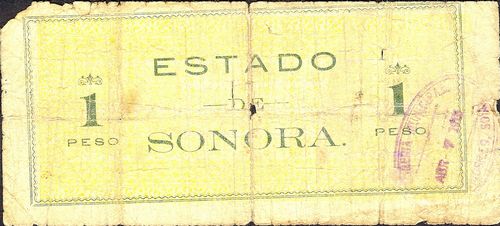
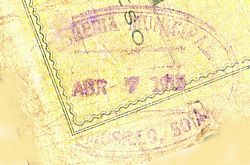 A violet oval seal with ‘TESORERÍA MUNICIPAL – HERMOSILLO, SON.’ and date.
A violet oval seal with ‘TESORERÍA MUNICIPAL – HERMOSILLO, SON.’ and date.
Hermosillo - Prefectura del Distrito
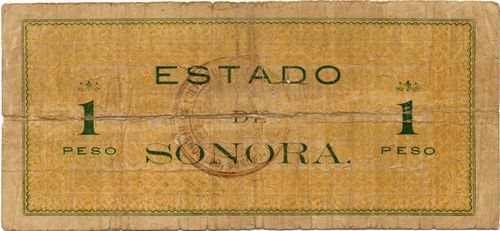
A circular seal with 'PREFECTURA DEL DISTRITO - HERMOSILLO, SONORA, MEX.'
Guaymas - Distrito de Rio Yaqui
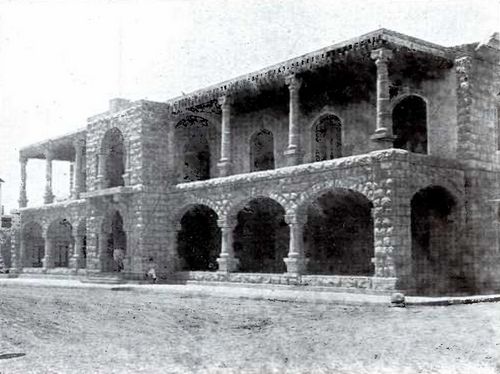
Palacio Municipal, Guaymas
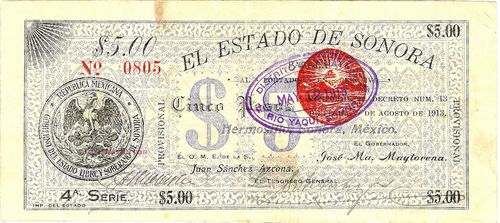
 A 45x27mm violet or black oval stamp with ‘DISTRITO DE GUAYMAS - RIO YAQUI, SONORA’ and date in centre. Known dates range from [9] May 1915 to [15] May 1915.
A 45x27mm violet or black oval stamp with ‘DISTRITO DE GUAYMAS - RIO YAQUI, SONORA’ and date in centre. Known dates range from [9] May 1915 to [15] May 1915.
We know that by May 1915 the notes were being restamped in the Municipal Treasury in GuaymasAGHES, Fondo Oficialidad Mayor, tomo 3024, letter Presidente Municipal, Guaymas to Gobernador, 10 May 1915 so this resello possibly comes from that building.
Guaymas - Aduana Marítima
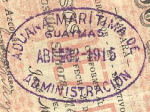 A blue or violet oval (44x30mm) rubber stamp with ‘ADUANA MARITIMA DE GUAYMAS – ADMINISTRACION’ and date in centre. Known dates range from [ ] March 1915 to [ ] May 1915 and the overprint is found on either the front or the back of the note.
A blue or violet oval (44x30mm) rubber stamp with ‘ADUANA MARITIMA DE GUAYMAS – ADMINISTRACION’ and date in centre. Known dates range from [ ] March 1915 to [ ] May 1915 and the overprint is found on either the front or the back of the note.
The customs at this time were housed in a former colonial barracks facing the quay, on the site where the statue of General Yanéz now looks out over the main square.
Some of these resellos were initialled by A. G. Rivas.
Cocorit - Tesorería Municipal
‘Tesoreria Municipal de Cocorit R. Y.’.
During the revolution Cocorit was the name of the municipio where the city of Ciudad Obregón was afterwards developed. It was the headquarters for the Prefecto of Guaymas from 19 August 1913 until July 1914, whilst the Huertistas held the port.
[ ] - Sindicatura

La Paz
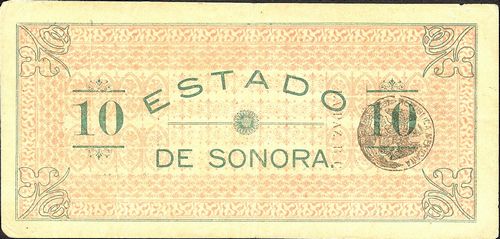
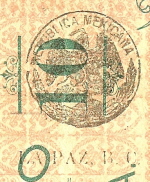 Circular seal with eagle and ‘REPUBLICA MEXICANA" with 'LA PAZ, B. C.’ below.
Circular seal with eagle and ‘REPUBLICA MEXICANA" with 'LA PAZ, B. C.’ below.
Southern Baja California was rather a backwater during the revolution. The Huertista General Osuna finally fled from La Paz in March 1914. As soon as Miguel L. Cornejo was installed as Constitutionalist Jefe Político, Monclova and Ejército Constitucionalista notes began to circulate. But the quantities sent over were not enough, so Carranza authorized Cornejo to issue notes of $5, $10 and $20 and vales of 5c, 10c and 50c.
By August the new government was publishing circulars received from Sotomayor in Hermosillo. On 11 November 1914 the authorities in Todos Santos asked La Paz whether Estado de Sonora notes were acceptable as businesses were handing them backABCS, Gobernación, vol. 628bis, exp. 143.
On [ ] Angulo ruled that the compulsory issue in the District was that of the Ejército Constitucionalista but because businesses and the general public possessed large quantities of other types of notes, such as the Monclova, dos caras, “Brigada de Sinaloa”, “Estado de Sonora” and Cornejo, he had decided to permit their circulation, with the resello of the Jefatura Política or corresponding Presidencia Municipal, with the exception of the Villista notesABCS, Gobernación, exp. 150, c 642. He set a punishment of a $500 fine or 60 days’ imprisonment for any storeholder who did not accept notes revalidated by the Jefatura Política ABCS, Gobernacion exp. 63, c 640 bis.
On 9 February 1915 Jefe Político Felix Ortega annulled the Cornejo issue. He said that his motive was to avoid the economic isolation of the territory, since the Cornejo notes were not accepted by businesses on the mainland and he was trying to put into circulation a paper currency that was acceptable in Sonora, Sinaloa and Tepic. He told the La Paz town council that holders of Cornejo notes could exchange them over time for money in general circulation (i.e. the first and second issues from Chihuahua (the sábanas and dos caras), and the issues of Pastor Rouaix in Durango, Felipe Riveros in Sinaloa and José Maria Maytorena in Sonora).
On 22 March 1915 businesses made an agreement with the Secretario de Gobierno to retire the local issues. The storekeepers agreed for two days (23 and 24 March) to accept the notes revalidated by the Jefatura Política at par and without any restriction: then they would then hold them until the government could change them for notes in general circulation. They also sent to Sonora for some fractional notes. For its part, the Jefatura Política would issue sufficient paper money to exchange any local currency that people still hadABCS, Gobernación, exp. 106, vol. 648. However, on learning of the agreement the Jefe Politico stated that the time allotted for bringing the fractional notes from Sonora was insufficient, so the day after the meeting he decreed that the Jefatura Política vales in circulation (and any put into circulation in future to replace notes that had deteriorated) would be of forced circulation within the District, irrespective of any steps taken to replace the local currency with that which was in use in the rest of the country. Despite the threat of a fine of at least fifty pesos, some merchants refused to accept the vales, so the authorisation was renewed at the end of March.
La Paz was under Villista control until May 1915 when the garrison rebelled.
La Paz - Comandancia Militar
‘Ejercito Constitucionalista - Comandancia Militar, La Paz, B. Cfa’
On 27 May 1915 General Felix Ortega, the Jefe Político and Comandante Militar of southern Baja California had decreed (núm. 12) that the paper currency of those states that submitted to the Convention were of forced circulation unless the Convention itself or Villa had decreed otherwise. By 3 August the Comandante Militar was reporting to Carranza in Veracruz and on 1 December all Ortega’s decrees were nulified by the Constitutionalist Comandante MilitarBoletín Oficial, La Paz, Tomo I, Núm. 7, 1 December 1915. This resello must belong to this transitional period.
San Luis Potosí - Prefectura Regional
A blue-green round rubber seal with ‘Prefectura Regional del Partido de la Capital. S.L.P.’ and eagle in centre.
An extremely rare overprint found on a $1 note3rd series 24165. Antonio Kalixtro Espinosa, Papel Moneda de la Revolución Mexicana que circula en San Luis Potosí, San Luis Potosí, 1981. On 14 April 1915 the Prefectura Regional of San Luis Potosí published a list of the currencies that the state government, in agreement with the Jefe de Hacienda and the Oficina de Canje y Revisión, had decreed to be of obligatory tender. These included the $1, $5 and $10 Estado de Sonora signed by Maytorena, Sánchez Azcona and RandallPeriódico Oficial, 17 April 1915.
Use in other states
As Maytorena supported Villa and the Convention against Carranza his notes were listed as of forced acceptance in Convention-dominated territories (e.g. in the Convention list of 22 January 1915, in Toluca, Estado de México on 29 January 1915 and Cuernavaca, Morelos on 12 February 1915).

